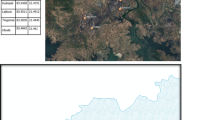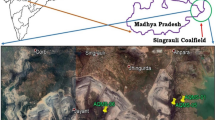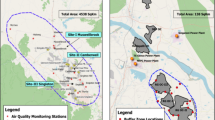Abstract
Jharia Coalfield (JCF) is one of the oldest coalfields in the eastern part of India and falls under critically polluted areas as per CPCB/MoEFCC Notification. Therefore, a study of air pollution and its management is the demand of the day. This study had been undertaken to know the current status of JCF concerning air quality. Ambient air quality monitoring with reference to particulate matter (PM10 and PM2.5), SO2, NOx and trace elements had been conducted in the coal mining areas of JCF. The study area was divided into two groups, mainly fire and non-fire for the sampling of air. Principal component analysis (PCA) identified coal mine fire as a major source of air pollution in the mining areas of JCF. Air quality index (AQI) was calculated which revealed that the air quality index of coal mine fire-affected areas was nearly 1.5 times higher than that of the non-mine fire areas.

Graphical abstract







Similar content being viewed by others
References
Abulude, F. O., Adeyeye, E. I., & Asaolu, S. S. (2003). Assessment of some heavy metals in mushroom samples from Ondo State, Nigeria. International Journal of Environmental Studies, 60(6), 535–536. https://doi.org/10.1080/0020723032000130070.
Afridi, H. I., Kazi, T. G., Kazi, N., Kandhro, G. A., Baig, J. A., Shah, A. Q., Khan, S., Kolachi, N. F., Wadhwa, S. K., Shah, F., Jamali, M. K., & Arain, M. B. (2011). Evaluation of cadmium, chromium, nickel, and zinc in biological samples of psoriasis patients living in Pakistani cement factory area. Biological Trace Element Research, 142(3), 284–301.
ASTDR (Agency for Toxic Substances and disease Registry) (1993). Toxicological profile for lead. Update. Prepared by Clement International Corporation under Contract No. 205-88-0608 for ASTDR. U.S. Public Health Service, Atlanta, GA.
Äyräs, M., & Kashulina, G. (2000). Regional patterns of element contents in the organic horizon of podzols in the central part of the Barents region (Finland, Norway and Russia) with special reference to heavy metals (Co, Cr, Cu, Fe, Ni, Pb, V and Zn) and sulphur as indicators of airborne pollution. Journal of Geochemical Exploration, 68(1–2), 127–144.
Baldauf, R. W. (2001). Ambient air quality monitoring network design for assessing human health impacts from exposures to airborne contaminants. Environmental Monitoring and Assessment, 66(1), 63–76. https://doi.org/10.1023/A:1026428214799.
Banerjee, A. D. K. (2003). Heavy metal levels and solid phase speciation in street dusts of Delhi, India. Environmental Pollution, 123(1), 95–105. https://doi.org/10.1016/S0269-7491(02)00337-8.
Basha, A. M., Yasovardhan, N., Satyanarayana, S. V., Reddy, G. V. S., & Kumar, A. V. (2014). Baseline survey of trace metals in ambient PM 10 at Tummalapalle uranium mining site. Atmospheric Pollution Research, 5(4), 591–600. https://doi.org/10.5094/APR.2014.068.
Bharat Coking Coalfield Limited (BCCL) (1991). Mine fires in the Jharia coalfield, Bharat Coking Coal Limited, Project andPlanning Division, Dhanbad, India, pp 1–17.
Bhuyan, P. K., Samantray, P., & Rout, S. P. (2010). Ambient air quality status in Choudwar area of Cuttack District. International journal of environmental sciences, 1(3), 343–356.
Birmili, W., Allen, A. G., Bary, F., & Harrison, R. M. (2006). Trace metal concentrations and water solubility in size-fractionated atmospheric particles and influence of road traffic. Environmental Science & Technology, 40(4), 1144–1153. https://doi.org/10.1021/es0486925.
Brunekreef, B., & Holgate, S. T. (2002). Air pollution and health. The Lancet, 360(9341), 1233–1242. 10.1016/S0140-6736(02)11274-8.
Charron, A., & Harrison, R. M. (2005). Fine (PM2. 5) and coarse (PM2. 5-10) particulate matter on a heavily trafficked London highway: sources and processes. Environmental Science & Technology, 39(20), 7768–7776. https://doi.org/10.1021/es050462i.
Cheng, H., & Hu, Y. (2010). Lead (Pb) isotopic fingerprinting and its applications in lead pollution studies in China: a review. Environmental Pollution, 158(5), 1134–1146. https://doi.org/10.1016/j.envpol.2009.12.028.
CPCB. 2012. Guidelines for the measurement of ambient air pollutants, vol. I (New Delhi).
Collins, M. J., Williams, P. L., & McIntosh, D. L. (2001). Ambient air quality at the site of a former manufactured gas plant. Environmental Monitoring and Assessment, 68(2), 137–152. https://doi.org/10.1023/A:1010747225479.
Coal India Limited (n.d.). https://www.coalindia.in/en-us/performance/physical.aspx. Accesssed 20 March 2018.
Danielsson, B. R., Hassoun, E., & Dencker, L. (1982). Embryotoxicity of chromium: distribution in pregnant mice and effects on embryonic cells in vitro. Archives of Toxicology, 51(3), 233–245.
Dubey, B., Pal, A. K., & Singh, G. (2012). Trace metal composition of airborne particulate matter in the coal mining and non–mining areas of Dhanbad Region, Jharkhand, India. Atmospheric Pollution Research, 3(2), 238–246. https://doi.org/10.5094/APR.2012.026.
Feng, X. D., Dang, Z., Huang, W. L., & Yang, C. (2009). Chemical speciation of fine particle bound trace metals. International Journal of Environmental Science & Technology, 6(3), 337–346. https://doi.org/10.1007/BF03326071.
Gautam, S., Prasad, N., Patra, A. K., Prusty, B. K., Singh, P., Pipal, A. S., & Saini, R. (2016). Characterization of PM2.5 generated from opencast coal mining operations: a case study of Sonepur Bazari Opencast Project of India. Environmental Technology & Innovation, 6, 1–10. https://doi.org/10.1016/j.eti.2016.05.003.
Guan, H., Van Genderen, JL. (1997). Report on environment monitoring of spontaneous combustion in the coal field of North China, Aero-Photogrammetry and Remote Sensing Bureau of China and International Institute for Aerospace survey and Earth Sciences, Enscheda, The Netherland.
Gummeneni, S., Yusup, Y. B., Chavali, M., & Samadi, S. Z. (2011). Source apportionment of particulate matter in the ambient air of Hyderabad city, India. Atmospheric Research, 101(3), 752–764. https://doi.org/10.1016/j.atmosres.2011.05.002.
Hall, J. L. (2002). Cellular mechanisms for heavy metal detoxification and tolerance. Journal of Experimental Botany, 53(366), 1–11. https://doi.org/10.1093/jexbot/53.366.1.
Haritash, A. K., & Kaushik, C. P. (2007). Assessment of seasonal enrichment of heavy metals in respirable suspended particulate matter of a sub-urban Indian city. Environmental Monitoring and Assessment, 128(1–3), 411–420. https://doi.org/10.1007/s10661-006-9335-1. http://www.foundryinfo-india.org/Critically_polluted_43_industrial_clusters_in.aspx (Accessed on 5th may, 2018). https://news.yale.edu/2018/01/23/2018-environmental-performance-index-air-quality-top-public-health-threat. (Accessed on 30.01.2018). https://www.greenpeace.org/southeastasia/press/679/latest-air-pollution-data-ranks-worlds-cities-worst-to-best/. (Accessed on 15.05.2018). www.indiaenvironmentportal.org.in› files › file › Air Quality Index. (Accessed on 23.07.2018).
IARC (2013). Outdoor air pollution a leading environmental cause of cancer deaths. IRIS (Integrated Risk Assessment System), vol. 1995. United States Environmental Protection Agency. www.epa.gov/IRIS/
Iijima, S., Matsumoto, N., & Lu, C.-C. (1983). Transfer of chromic chloride to embryonic mice and changes in the embryonic mouse neuroepithelium. Toxicology, 26(3–4), 257–265. https://doi.org/10.1016/0300-483X(83)90086-0.
Jena, S., & Singh, G. (2017). Human health risk assessment of airborne trace elements in Dhanbad, India. Atmospheric Pollution Research, 8(3), 490–502. https://doi.org/10.1016/j.apr.2016.12.003.
Karar, K., Gupta, A. K., Kumar, A., & Biswas, A. K. (2006). Characterization and identification of the sources of chromium, zinc, lead, cadmium, nickel, manganese and Iron in PM10 particulates at the two sites of Kolkata, India. Environmental Monitoring and Assessment, 120(1–3), 347–360. https://doi.org/10.1007/s10661-005-9067-7.
Khare, P., & Baruah, B. P. (2010). Elemental characterization and source identification of PM2.5 using multivariate analysis at the suburban site of North-East India. Atmospheric Research, 98(1), 148–162. https://doi.org/10.1016/j.atmosres.2010.07.001.
Koukoulakis, K. G., Chrysohou, E., Kanellopoulos, P. G., Karavoltsos, S., Katsouras, G., Dassenakis, M., Nikolelis, D., & Bakeas, E. (2019). Trace elements bound to airborne PM10 in a heavily industrialized site nearby Athens: seasonal patterns, emission sources, health implications. Atmospheric Pollution Research, 10(4), 1347–1356. https://doi.org/10.1016/j.apr.2019.03.007.
Kuenzer, C., & Stracher, G. B. (2012). Geomorphology of coal seam fires. Geomorphology, 138(1), 209–222. https://doi.org/10.1016/j.geomorph.2011.09.004.
Kuenzer, C., Zhang, J., Tetzlaff, A., van Dijk, P., Voigt, S., Mehl, H., & Wagner, W. (2007). Uncontrolled coal fires and their environmental impacts: investigating two arid mining regions in north-central China. Applied Geography, 27(1), 42–62. https://doi.org/10.1016/j.apgeog.2006.09.007.
Lee, B.-K., Jun, N.-Y., & Lee, H. K. (2005). Analysis of impacts on urban air quality by restricting the operation of passenger vehicles during Asian Game events in Busan, Korea. Atmospheric Environment, 39(12), 2323–2338. https://doi.org/10.1016/j.atmosenv.2004.11.044.
Leili, M., Naddafi, K., Nabizadeh, R., Yunesian, M., & Mesdaghinia, A. (2008). The study of TSP and PM10 concentration and their heavy metal content in central area of Tehran, Iran. Air Quality, Atmosphere & Health, 1(3), 159–166. https://doi.org/10.1007/s11869-008-0021-z.
Li, S., Matthews, J., & Sinha, A. (2008). Atmospheric hydroxyl radical production from electronically excited NO2 and H2O. Science, 319(5870), 1657–1660. https://doi.org/10.1126/science.1151443.
Limbeck, A., Handler, M., Puls, C., Zbiral, J., Bauer, H., & Puxbaum, H. (2009). Impact of mineral components and selected trace metals on ambient PM10 concentrations. Atmospheric Environment, 43(3), 530–538. https://doi.org/10.1016/j.atmosenv.2008.10.012.
López, J. M., Callén, M. S., Murillo, R., García, T., Navarro, M. V., de la Cruz, M. T., & Mastral, A. M. (2005). Levels of selected metals in ambient air PM10 in an urban site of Zaragoza (Spain). Environmental Research, 99(1), 58–67. https://doi.org/10.1016/j.envres.2005.01.007.
Mahowald, N. M., Baker, A. R., Bergametti, G., Brooks, N., Duce, R. A., Jickells, T. D., et al. (2005). Atmospheric global dust cycle and iron inputs to the ocean: atmospheric iron deposition. Global Biogeochemical Cycles, 19(4), n/a-n/a. https://doi.org/10.1029/2004GB002402.
Malandrino, M., Di Martino, M., Ghiotti, G., Geobaldo, F., Grosa, M. M., Giacomino, A., & Abollino, O. (2013a). Inter-annual and seasonal variability in PM10 samples monitored in the city of Turin (Italy) from 2002 to 2005. Microchemical Journal, 107, 76–85. https://doi.org/10.1016/j.microc.2012.05.026.
Malandrino, M., Di Martino, M., Giacomino, A., Geobaldo, F., Berto, S., Grosa, M. M., & Abollino, O. (2013b). Temporal trends of elements in Turin (Italy) atmospheric particulate matter from 1976 to 2001. Chemosphere, 90(10), 2578–2588. https://doi.org/10.1016/j.chemosphere.2012.10.102.
Manalis, N., Grivas, G., Protonotarios, V., Moutsatsou, A., Samara, C., & Chaloulakou, A. (2005). Toxic metal content of particulate matter (PM10), within the Greater Area of Athens. Chemosphere, 60(4), 557–566. https://doi.org/10.1016/j.chemosphere.2005.01.003.
Mancuso, T. F. (1975). Consideration of chromium as an industrial carcinogen. Toronto, Ontario: In International Conference on Heavy Metals in the Environment, 343–56.
Marcazzan, G. M., Vaccaro, S., Valli, G., & Vecchi, R. (2001). Characterisation of PM10 and PM2.5 particulate matter in the ambient air of Milan (Italy). Atmospheric Environment, 35(27), 4639–4650. https://doi.org/10.1016/S1352-2310(01)00124-8.
Masih, J., Dyavarchetty, S., Nair, A., Taneja, A., & Singhvi, R. (2019). Concentration and sources of fine particulate associated polycyclic aromatic hydrocarbons at two locations in the western coast of India. Environmental Technology & Innovation, 13, 179–188. https://doi.org/10.1016/j.eti.2018.10.012.
Matsumoto, N., Iijima, S., & Katsunuma, H. (1976). Placental transfer of chromic chloride and its teratogenic potential in embryonic mice. The Journal of Toxicological Sciences, 1(2), 1–13. https://doi.org/10.2131/jts.1.2_1.
Meena, M., Meena, B. S., Chandrawat, U., & Rani, A. (2016). Seasonal variation of selected metals in particulate matter at an industrial city Kota, India. Aerosol and Air Quality Research, 16(4), 990–999. https://doi.org/10.4209/aaqr.2015.02.0074.
National Ambient Air Quality Standards (2009). Notification, New Delhi, the 18th November.
National Remote Sensing Agency (NRSA), Hyderabad (2006). Report on coal mine fire delineation and surface features mapping using satellite data in Jharia coal field, Dhanbad Jharkhand.
Padoan, E., Malandrino, M., Giacomino, A., Grosa, M. M., Lollobrigida, F., Martini, S., & Abollino, O. (2016). Spatial distribution and potential sources of trace elements in PM10 monitored in urban and rural sites of Piedmont Region. Chemosphere, 145, 495–507. https://doi.org/10.1016/j.chemosphere.2015.11.094.
Pandey, B., Agrawal, M., & Singh, S. (2014). Assessment of air pollution around coal mining area: emphasizing on spatial distributions, seasonal variations and heavy metals, using cluster and principal component analysis. Atmospheric Pollution Research, 5(1), 79–86. https://doi.org/10.5094/APR.2014.010.
Pandey, J., Kumar, D., Singh, V. K., & Mohalik, N. K. (2016). Environmental and socio-economic impacts of fire in Jharia Coalfield, Jharkhand, India: an appraisal. Current Science, 110(9), 1639. https://doi.org/10.18520/cs/v110/i9/1639-1650.
Park, R. M., Bena, J. F., Stayner, L. T., Smith, R. J., Gibb, H. J., & Lees, P. S. J. (2004). Hexavalent chromium and lung cancer in the chromate industry: a quantitative risk assessment. Risk Analysis, 24(5), 1099–1108. https://doi.org/10.1111/j.0272-4332.2004.00512.x.
Pathak, A. K., Yadav, S., Kumar, P., & Kumar, R. (2013). Source apportionment and spatial–temporal variations in the metal content of surface dust collected from an industrial area adjoining Delhi, India. Science of the Total Environment, 443, 662–672. https://doi.org/10.1016/j.scitotenv.2012.11.030.
Patra, A. K., Gautam, S., & Kumar, P. (2016). Emissions and human health impact of particulate matter from surface mining operation—a review. Environmental Technology & Innovation, 5, 233–249. https://doi.org/10.1016/j.eti.2016.04.002.
Pedersen, N. B. (1982). The effects of chromium on the skin. In Biological and environmental aspects of chromium, 249–275.
Prodi, F., Belosi, F., Contini, D., Santachiara, G., Di Matteo, L., Gambaro, A., et al. (2009). Aerosol fine fraction in the Venice Lagoon: particle composition and sources. Atmospheric Research, 92(2), 141–150. https://doi.org/10.1016/j.atmosres.2008.09.020.
Quiterio, S. L., Sousa da Silva, C. R., Arbilla, G., & Escaleira, V. (2004). Metals in airborne particulate matter in the industrial district of Santa Cruz, Rio de Janeiro, in an annual period. Atmospheric Environment, 38(2), 321–331. https://doi.org/10.1016/j.atmosenv.2003.09.017.
Roy, P., Kumar Sikdar, P., Singh, G., & Kumar Pal, A. (2012). Source apportionment of ambient PM10: a case study from a mining belt of Orissa. Atmósfera, 25(3), 311–324.
Senlin, L., Longyi, S., Minghong, W., Zheng, J., & Xiaohui, C. (2007). Chemical elements and their source apportionment of PM10 in Beijing urban atmosphere. Environmental Monitoring and Assessment, 133(1–3), 79–85. https://doi.org/10.1007/s10661-006-9561-6.
Shaheen, N., Shah, M. H., Khalique, A., & Jaffar, M. (2005). Metal levels in airborne particulate matter in urban Islamabad, Pakistan. Bulletin of Environmental Contamination and Toxicology, 75(4), 739–746. https://doi.org/10.1007/s00128-005-0813-x.
Shridhar, V., Khillare, P. S., Agarwal, T., & Ray, S. (2010). Metallic species in ambient particulate matter at rural and urban location of Delhi. Journal of Hazardous Materials, 175(1–3), 600–607. https://doi.org/10.1016/j.jhazmat.2009.10.047.
Singh, G., Roy, D., & Sinha, S. (2014). Ambient air quality assessment with particular reference to particulates in Jharia Coalfield, Eastern India. Journal of Environmental Science & Engineering, 56(1), 19–30.
Song, Z., Zhu, H., Jia, G., & He, C. (2014). Comprehensive evaluation on self-ignition risks of coal stockpiles using fuzzy AHP approaches. Journal of Loss Prevention in the Process Industries, 32, 78–94. https://doi.org/10.1016/j.jlp.2014.08.002.
Tripathi, A. K., & Gautam, M. (2007). Biochemical parameters of plants as indicators of air pollution. Journal of Environmental Biology, 28(1), 127–132.
Tasdemir, Y., Kural, C., Cindoruk, S. S., & Vardar, N. (2006). Assessment of trace element concentrations and their estimated dry deposition fluxes in an urban atmosphere. Atmospheric Research, 81(1), 17–35.
U.S. ATSDR (U.S. Agency for Toxic Substances and Disease Registry). (2005). Toxicological profile for lead, U.S. Department of Health and Human Services, Public Health Service, Atlanta, U.S.A, p. 582.
USEPA (Environmental Protection Agency) (1990). Air quality criteria for lead: supplement to the 1986 Addendum. Environmental Criteria and Assessment Office, Research Triangle Park, NC. EPA-600/8e89/049F.
Weckwerth, G. (2001). Verification of traffic emitted aerosol components in the ambient air of Cologne (Germany). Atmospheric Environment, 35(32), 5525–5536. https://doi.org/10.1016/S1352-2310(01)00234-5.
Yadav, M., Sahu, S. P., & Singh, N. K. (2019). Multivariate statistical assessment of ambient air pollution in two coalfields having different coal transportation strategy: a comparative study in Eastern India. Journal of Cleaner Production, 207, 97–110. https://doi.org/10.1016/j.jclepro.2018.09.254.
Zhang, J., Wagner, W., Prakash, A., Mehl, H., & Voigt, S. (2004). Detecting coal fires using remote sensing techniques. International Journal of Remote Sensing, 25(16), 3193–3220. https://doi.org/10.1080/01431160310001620812.
Zhang, F., Chen, Y., Tian, C., Wang, X., Huang, G., Fang, Y., & Zong, Z. (2014). Identification and quantification of shipping emissions in Bohai Rim, China. Science of the Total Environment, 497–498, 570–577. https://doi.org/10.1016/j.scitotenv.2014.08.016.
Acknowledgments
The authors are grateful to the Indian Institute Technology (Indian School of Mines) Dhanbad for providing all the necessary laboratory facilities during the research work. One of the authors (Shilpi Mondal) is also thankful to the Ministry of Human Resource Development for providing IIT (ISM) JRF fellowship.
Author information
Authors and Affiliations
Corresponding author
Ethics declarations
Conflict of interest
The authors declare that they have no conflict of interest.
Human and animal rights
This article does not contain any studies with human or animal subjects performed by any of the authors. The manuscript has been prepared following the instructions provided in the Author’s Guidelines of the journal.
Additional information
Publisher’s note
Springer Nature remains neutral with regard to jurisdictional claims in published maps and institutional affiliations.
Electronic supplementary material
ESM 1
(DOCX 31 kb)
Rights and permissions
About this article
Cite this article
Mondal, S., Singh, G. & Jain, M.K. Spatio-temporal variation of air pollutants around the coal mining areas of Jharia Coalfield, India. Environ Monit Assess 192, 405 (2020). https://doi.org/10.1007/s10661-020-08324-z
Received:
Accepted:
Published:
DOI: https://doi.org/10.1007/s10661-020-08324-z




